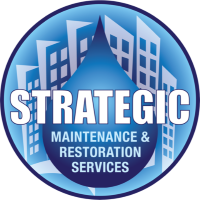Cleaning LVT or Luxury Vinyl Tile
LVT or Luxury Vinyl Tile or LVP Luxury Vinyl Planks are very popular right now. They are being installed everywhere. Both Residential and Commercial installations can be seen in homes, hospitals and office buildings. Most of the time it is being sold a a floor that needs little maintenance. This is far from the truth. Every floor needs maintenance. Choosing the correct way to maintain is vitally important.
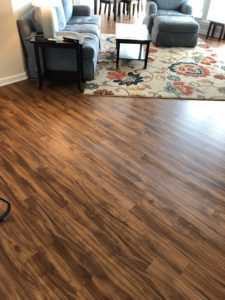
Let's take a look how different types of flooring treat soil. Carpet is designed to trap and hold soil until it is cleaned. LVT or LVP, manufactured wood, stone, tile and other hard surfaces need weekly or even daily sweeping and mopping to keep up with the soiling. The soil will find its way to the floor no matter what product you install on it. This soil buildup can eventually scratch the LVT or LVP wear layer that can make your floor look dull.
LVT can be a great product for your home our business however problems associated with cleaning an LVT floor can start with a poor installation or specification. These LVT floors can be glued down or float on the subfloor. A floating LVT floor is when the tiles or planks are clicked together, usually over an existing surface (old floor covering, subfloor, cushion or moisture barrier), with the thought that it can move as a unit if it swells, expands or shrinks. Other issues can occur because of excessive sunlight, heat or even high humidity. Water that gets under the floor can be a disaster. Subfloors that are not flat can also put pressure on the joints creating separation at joints.
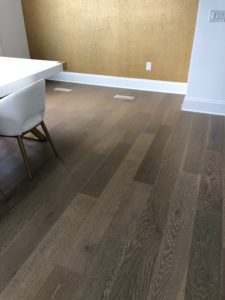 Each manufacture has different ways you click the planks together. If these clicks are damaged during the installation or not done properly, even waterproof LVT can look bad after cleaning.
Each manufacture has different ways you click the planks together. If these clicks are damaged during the installation or not done properly, even waterproof LVT can look bad after cleaning.
Lets say someone thinks they can just mop the floor with a disinfectant or other cleaning agent. This may ruin the wear layer, which is like the protective coating of the LVT or LVP. This may cause marks and blemishes that are sometimes impossible to remove. Some think that some kind of wax may help. Wax will usually void warranties. So know what you are using to clean?
Here is the skinny:
Products typically bought at Home Depot, Lowes and Hardware Stores for the maintenance of LVT are not monitored by a hard surface association that test products for performance on all manufactured LVT. The CRI or Carpet & Rug Institute test carpet and the cleaning solutions for performance. Why is this not being done for LVT?
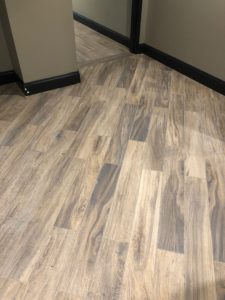
There are so many different hard surface finishes, so many different LVT & LVP product lines, that one product, even if tested to see if it cleans better than water and does not leave a residue, would not be right for all products made. So being on the safe side, look at your maintenance guidelines, call the manufacturer or consult a professional cleaner before you start maintaining using a product that you see in your grocery or hardware store.
For Now:
- Although sometimes vague or nonexistant, follow the manufactures cleaning guidelines and cleaning recommendations first. If manufactures recommendations are not available follow steps listed below.
Safe way to clean LVT:
- Sweep or Vacuum Thoroughly (Do not use a beater bar brush)
- Stay away from Polishes, Powders and Waxes
- Do not use disinfectants unless approved by manufacture.
- Clean with a Neutral pH Cleaner.
- Use a flat mop with a microfiber.
- Do not over wet, pour water on the floor or leave puddles.
- Wring out and clean your microfiber often.
Some Manufactures Maintenance Guidelines
Mohawk:
- Spills should be cleaned up immediately.
- Wash the floor with nonabrasive floor cleaner.
- Never push, pull, or drag furniture across vinyl floors. Always lift and carry.
- Heavy furniture or appliances that are not moved often should be equipped with flat, nonstaining floor protectors.
- Avoid using a vacuum with a beater bar.
- For spot stain treatment, use a diluted bleach solution that is 1 part bleach, 10 parts water.
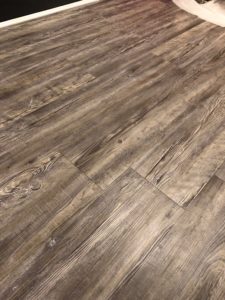
Shaw:
- Remove dirt and grit by sweeping or dust mopping daily.
- Wipe up spills as quickly as possible.
- Use protective pads for furniture and appliances to prevent scratching.
- Avoid exposure to direct sunlight for prolonged periods of time.
- Recommend Shaw’s R2X®
Hard Surfaces Flooring Cleanerand Shaw’s EPA/Dfe Green Formula Hard SurfacesFlooring Cleaner are recommended for general spottingand cleaning.
Interface:
- Broom, Dust Mop with a Microfiber Cloth and/or Suction-Only Vacuum Cleaner
- Microfiber Mop – DO NOT USE STRING MOPS ON INTERFACE LVT
- Neutral pH Cleaning Solution (pH of 6.0-8.0)
All Others: Follow Manufactures Maintenance Guidelines.
